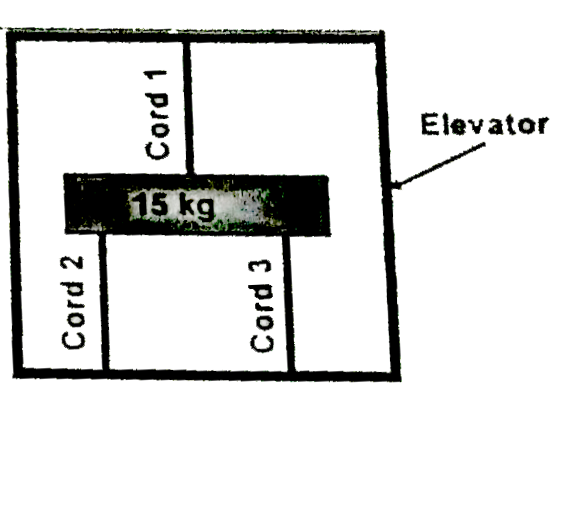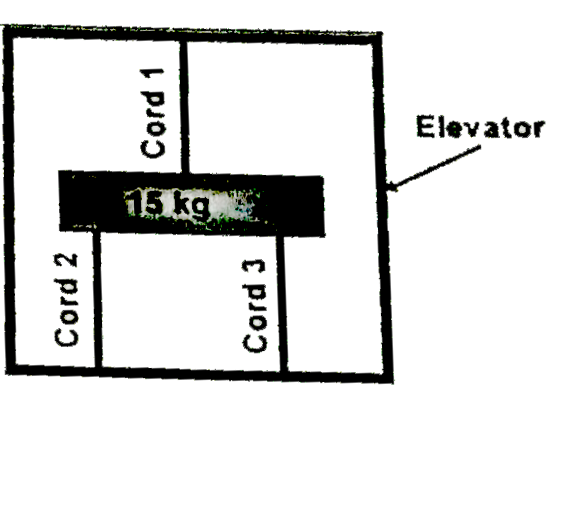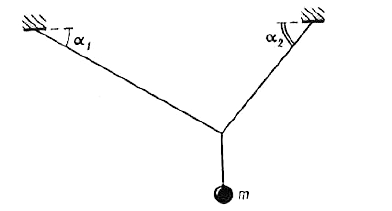A bead of mass 2.5×10−4 kg is suspended from a cord. A steady horizontal breeze pushes the bead so that the cord makes a constant angle of 40∘ with the vertical. Find (a) the tension in the cord and (b) the push magnitude.
(a) 3.2 mN, (b) 2.1 mN
Related Playlists
- BOOK - RESNICK AND HALLIDAYCHAPTER - FORCE AND MOTION - I EXERCISE - PRACTICE QUESTIONS (Single Correct Choice Type)36videos
FORCE AND MOTION - I
- BOOK - RESNICK AND HALLIDAYCHAPTER - FORCE AND MOTION - I EXERCISE - PRACTICE QUESTIONS (More than One Correct Choice Type)5videos
FORCE AND MOTION - I
- BOOK - RESNICK AND HALLIDAYCHAPTER - FORCE AND MOTION - I EXERCISE - CHECKPOINT5videos
FORCE AND MOTION - I
- BOOK - RESNICK AND HALLIDAYCHAPTER - FLUIDSEXERCISE - PRACTICE QUESTIONS (Integer Type )5videos
FLUIDS
- BOOK - RESNICK AND HALLIDAYCHAPTER - FORCE AND MOTION-IIEXERCISE - PRACTICE QUESTIONS (Integer Type)1videos
FORCE AND MOTION-II
Knowledge Check
- Question 1 - Select One
A mass of 10 kg is suspended from a spring balance. It is pulled aside by a horizontal string so that it makes an angle of 60∘ with the vertical. The new rading of the balance is
A20 kg-wtB10 kg-wtC10√3 kg-wtD20√3 kg-wt - Question 1 - Select One
A mass of 10 kg is suspended from a spring balance, it is pulled aside by a horizontal string so that it makes an angle 60∘ with the vertical. The new reading of the balance is:
A10√3 kg wtB20√3 kg wtC20 kg wtD10 kg wt - Question 1 - Select One
A heavy particle of mass 1kg suspended from a massless string attached to a roof. A horizontal force F is applied to the particle such that in the equilibrium position the string makes and angle 30∘ with the vertical. The magnitude of the force F equals
 .A10NB10√3NC5ND10√3N
.A10NB10√3NC5ND10√3N - Question 1 - Select One
The bob of a 0.2 m pendulum describes an arc of circle in a vertical plane. If the tension in the cord is √3 times the weight of the bob when the cord makes an angle 30∘ with the vertical, the acceleration of the bob in that position is
AgBg2C√3g2Dg4 - Question 1 - Select One
A block of mass m=15g is suspended in an elevator with the help of three identical light elastic cords (spring constant k=100N/m each) attached vertically. One of them cord 1 is tied to the ceilling of the elevator and the other two cords 2 and 3 are tied to the elevator floor as shown in the figure. When the elevator is stationary the tension force is each of the lower cords is T=7.5N. Take g=10m/s2. Now the elevator starts moving with given four accelerations shown in column I. Column II given the displacement of the block with respect to elevator when its is accelerating. Column III gives tension in the cords when elevator is accelerating.


Tension in cord -2A(I)(iv)(P)B(II)(i)(Q)C(III)(iii)(R)D(IV)(ii)(S) - Question 1 - Select One or More
A block of mass m=15g is suspended in an elevator with the help of three identical light elastic cords (spring constant k=100N/m each) attached vertically. One of them cord 1 is tied to the ceilling of the elevator and the other two cords 2 and 3 are tied to the elevator floor as shown in the figure. When the elevator is stationary the tension force is each of the lower cords is T=7.5N. Take g=10m/s2. Now the elevator starts moving with given four accelerations shown in column I. Column II given the displacement of the block with respect to elevator when its is accelerating. Column III gives tension in the cords when elevator is accelerating.


Tension in cord -1A(I)(i)(S)B(II)(i)(R)C(III)(iii)(P)D(IV)(iii)(Q) - Question 1 - Select One
A block of mass m=15g is suspended in an elevator with the help of three identical light elastic cords (spring constant k=100N/m each) attached vertically. One of them cord 1 is tied to the ceilling of the elevator and the other two cords 2 and 3 are tied to the elevator floor as shown in the figure. When the elevator is stationary the tension force is each of the lower cords is T=7.5N. Take g=10m/s2. Now the elevator starts moving with given four accelerations shown in column I. Column II given the displacement of the block with respect to elevator when its is accelerating. Column III gives tension in the cords when elevator is accelerating.


Tension in cord -3A(I)(i)(P)B(II)(ii)(P)C(III)(iii)(S)D(IV)(iii)(R)
Similar Questions
(a) How many revolutions per minute must the apparatus shown in figure make about a vertical axis so that the cord makes an angle of 45∘ with the vertical ?

(b)What is the tension in the cord then? Given, l=√2m,a=20cm and m=5.0kg?View SolutionA weight of mass m is suspended from a cord so that one section of it makes an angle alph1 with the horizontal and the other - an angle α2 (Fig.). Find the tension of these sections of the cord.
 View Solution
View SolutionThe bob of a 0.2 m pendulum describs an arc of circle in a vertical plane. If the tension in the cord is √3 times the weight of the bob when the cord makes an angle 30∘ with the vertical, the acceleration of the bob in that position is g/n. Find value of n.
View Solution

